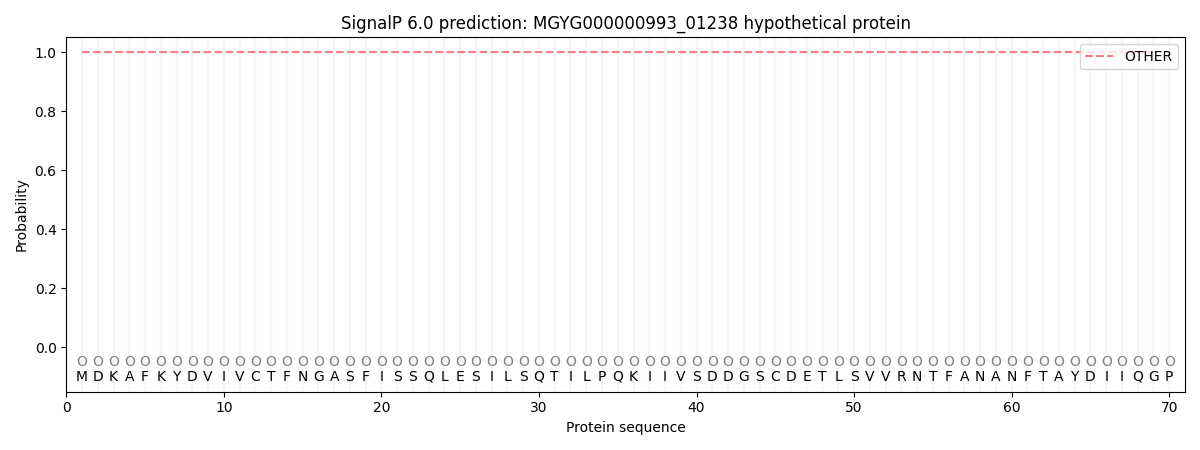You are browsing environment: HUMAN GUT
CAZyme Information: MGYG000000993_01238
You are here: Home > Sequence: MGYG000000993_01238
Basic Information |
Genomic context |
Full Sequence |
Enzyme annotations |
CAZy signature domains |
CDD domains |
CAZyme hits |
PDB hits |
Swiss-Prot hits |
SignalP and Lipop annotations |
TMHMM annotations
Basic Information help
| Species | Haemophilus_D sp900756155 | |||||||||||
|---|---|---|---|---|---|---|---|---|---|---|---|---|
| Lineage | Bacteria; Proteobacteria; Gammaproteobacteria; Enterobacterales; Pasteurellaceae; Haemophilus_D; Haemophilus_D sp900756155 | |||||||||||
| CAZyme ID | MGYG000000993_01238 | |||||||||||
| CAZy Family | GT2 | |||||||||||
| CAZyme Description | hypothetical protein | |||||||||||
| CAZyme Property |
|
|||||||||||
| Genome Property |
|
|||||||||||
| Gene Location | Start: 53492; End: 54376 Strand: - | |||||||||||
CDD Domains download full data without filtering help
| Cdd ID | Domain | E-Value | qStart | qEnd | sStart | sEnd | Domain Description |
|---|---|---|---|---|---|---|---|
| cd04196 | GT_2_like_d | 1.93e-82 | 8 | 226 | 1 | 212 | Subfamily of Glycosyltransferase Family GT2 of unknown function. GT-2 includes diverse families of glycosyltransferases with a common GT-A type structural fold, which has two tightly associated beta/alpha/beta domains that tend to form a continuous central sheet of at least eight beta-strands. These are enzymes that catalyze the transfer of sugar moieties from activated donor molecules to specific acceptor molecules, forming glycosidic bonds. Glycosyltransferases have been classified into more than 90 distinct sequence based families. |
| cd00761 | Glyco_tranf_GTA_type | 8.51e-18 | 9 | 117 | 1 | 108 | Glycosyltransferase family A (GT-A) includes diverse families of glycosyl transferases with a common GT-A type structural fold. Glycosyltransferases (GTs) are enzymes that synthesize oligosaccharides, polysaccharides, and glycoconjugates by transferring the sugar moiety from an activated nucleotide-sugar donor to an acceptor molecule, which may be a growing oligosaccharide, a lipid, or a protein. Based on the stereochemistry of the donor and acceptor molecules, GTs are classified as either retaining or inverting enzymes. To date, all GT structures adopt one of two possible folds, termed GT-A fold and GT-B fold. This hierarchy includes diverse families of glycosyl transferases with a common GT-A type structural fold, which has two tightly associated beta/alpha/beta domains that tend to form a continuous central sheet of at least eight beta-strands. The majority of the proteins in this superfamily are Glycosyltransferase family 2 (GT-2) proteins. But it also includes families GT-43, GT-6, GT-8, GT13 and GT-7; which are evolutionarily related to GT-2 and share structure similarities. |
| pfam00535 | Glycos_transf_2 | 1.44e-12 | 8 | 125 | 1 | 119 | Glycosyl transferase family 2. Diverse family, transferring sugar from UDP-glucose, UDP-N-acetyl- galactosamine, GDP-mannose or CDP-abequose, to a range of substrates including cellulose, dolichol phosphate and teichoic acids. |
| COG0463 | WcaA | 8.93e-12 | 6 | 115 | 4 | 111 | Glycosyltransferase involved in cell wall bisynthesis [Cell wall/membrane/envelope biogenesis]. |
| cd06420 | GT2_Chondriotin_Pol_N | 7.72e-07 | 9 | 119 | 1 | 106 | N-terminal domain of Chondroitin polymerase functions as a GalNAc transferase. Chondroitin polymerase is a two domain, bi-functional protein. The N-terminal domain functions as a GalNAc transferase. The bacterial chondroitin polymerase catalyzes elongation of the chondroitin chain by alternatively transferring the GlcUA and GalNAc moiety from UDP-GlcUA and UDP-GalNAc to the non-reducing ends of the chondroitin chain. The enzyme consists of N-terminal and C-terminal domains in which the two active sites catalyze the addition of GalNAc and GlcUA, respectively. Chondroitin chains range from 40 to over 100 repeating units of the disaccharide. Sulfated chondroitins are involved in the regulation of various biological functions such as central nervous system development, wound repair, infection, growth factor signaling, and morphogenesis, in addition to its conventional structural roles. In Caenorhabditis elegans, chondroitin is an essential factor for the worm to undergo cytokinesis and cell division. Chondroitin is synthesized as proteoglycans, sulfated and secreted to the cell surface or extracellular matrix. |
CAZyme Hits help
| Hit ID | E-Value | Query Start | Query End | Hit Start | Hit End |
|---|---|---|---|---|---|
| QOR17553.1 | 6.68e-205 | 1 | 294 | 1 | 294 |
| AGO01101.1 | 8.03e-205 | 1 | 294 | 6 | 299 |
| QTO00968.1 | 1.33e-192 | 7 | 294 | 4 | 291 |
| ACX83064.1 | 1.32e-148 | 5 | 294 | 5 | 290 |
| BAA28140.1 | 1.32e-148 | 5 | 294 | 5 | 290 |
Swiss-Prot Hits download full data without filtering help
| Hit ID | E-Value | Query Start | Query End | Hit Start | Hit End | Description |
|---|---|---|---|---|---|---|
| P37783 | 8.27e-12 | 11 | 225 | 1 | 212 | dTDP-rhamnosyl transferase RfbG OS=Shigella flexneri OX=623 GN=rfbG PE=3 SV=1 |
| Q0P9C6 | 1.45e-06 | 6 | 159 | 3 | 144 | GalNAc(5)-diNAcBac-PP-undecaprenol beta-1,3-glucosyltransferase OS=Campylobacter jejuni subsp. jejuni serotype O:2 (strain ATCC 700819 / NCTC 11168) OX=192222 GN=pglI PE=1 SV=1 |
SignalP and Lipop Annotations help
This protein is predicted as OTHER

| Other | SP_Sec_SPI | LIPO_Sec_SPII | TAT_Tat_SPI | TATLIP_Sec_SPII | PILIN_Sec_SPIII |
|---|---|---|---|---|---|
| 1.000053 | 0.000000 | 0.000000 | 0.000000 | 0.000000 | 0.000000 |
